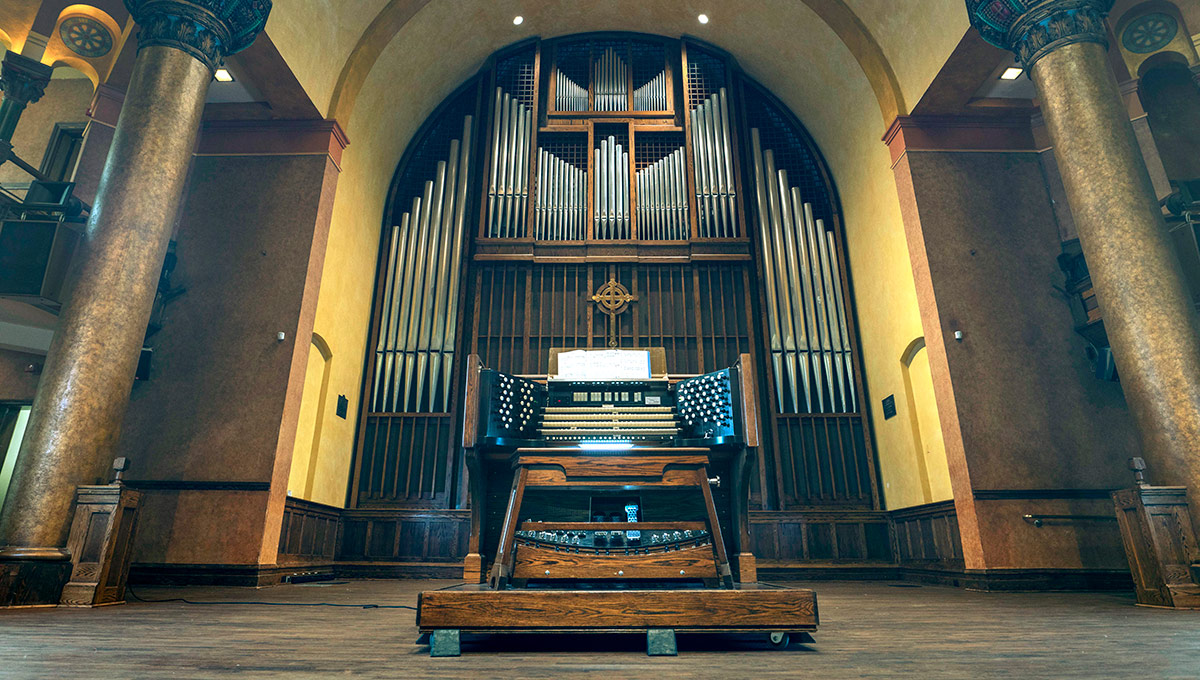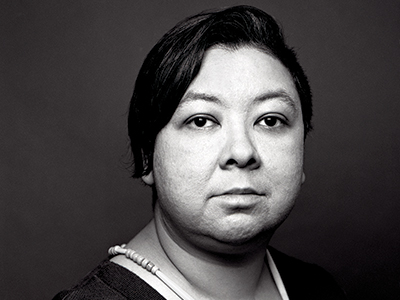By Meredith Boerchers
Photos by Chris Roussakis
Praised by Mozart as “the king of the instruments,” the pipe organ reigns over church sanctuaries and has become a stalwart symbol of ecclesiastical tradition. But at the Carleton Dominion Chalmers Centre (CDCC), the university’s arts, performance and learning hub in downtown Ottawa, the recently-restored, seven-storey, 5,179-pipe organ tells a surprising story of innovation and transition.
 The instrument’s roots pre-date the amalgamation of Dominion United Church and Chalmers United Church. In 1955, smoke and humidity during a fire at Chalmers significantly damaged the organ. “Playing in chords,” the music director at the time, William France, said about the fire’s impact, “has taken on the sound of marching armies.”
The instrument’s roots pre-date the amalgamation of Dominion United Church and Chalmers United Church. In 1955, smoke and humidity during a fire at Chalmers significantly damaged the organ. “Playing in chords,” the music director at the time, William France, said about the fire’s impact, “has taken on the sound of marching armies.”
The cost of restoration was prohibitively expensive, so the instrument remained unattended until after the 1961 fire that destroyed the Dominion church and led to the union of the two congregations. Enriched by the insurance payout funds received by Dominion, the newly amalgamated church chose the battered organ as its first major project.
Two established firms submitted bids: Quebec-based Casavant Frères (which had built the original Chalmers organ in 1928) and England’s William Hill & Son & Norman & Beard Limited. While the English manufacturer recommended a restoration, Casavant proposed a complete replacement.
Faced with two costly options, the church sought advice. A Royal Conservatory of Music organist thundered that the Hill, Norman and Beard organ he had recently played was “the worst instrument I have ever experienced.” A musician in Kingston called Casavant’s building techniques “wasteful” and “sinful.”
France was outspoken about his preference: “Frankly I mistrust a rebuild on an organ that has been tried by fire and water. There is the parallel of rebuilding a 1928 car!”
These passionate responses provide a snapshot of the organ reform movement, which started in early 20th-century Germany. Both the construction and timbre of organs had radically changed in the previous decades in concert with technological developments and musical taste, transforming a predominantly ecclesiastical instrument into an imitator of the orchestra within theatres and fairs.
Musicians and builders in the 1920s sought to re-create organs capable of playing the contrapuntal masterpieces of the past, and this “neo- classical” aesthetic spread to North America after World War II, when organists on duty with military forces had visited the historic organs of Europe.

Carleton Dominion-Chalmers Centre Goes Back to the Future
By the time Dominion-Chalmers began its search, the new approach to organ building was at its climax, with firms like Casavant returning to classic principles of mechanical action, wind systems and casework.
Convinced that Casavant’s organs were among the best in the world, Dominion-Chalmers chose the Canadian manufacturer in 1963. Established in 1879, Casavant is Canada’s oldest organ building firm still in operation, and the organ built and installed in Dominion-Chalmers represents a unique intersection in the history of both the company and Canada.
During the organ’s construction, the neo-classical clarity of sound was already established as the desired tonal palette, but the transition back to classical construction practices had not been completely implemented. It was during the years of Dominion- Chalmers’ organ construction that Casavant made the switch away from electro-pneumatic action — which uses electric current to send signals from the console to the wind chest — back to tracker action.
Rather than installing a series of mechanical linkages to the organ console as they would with future organs, Casavant used a total of six miles of copper wire to meticulously attach each of the organ console’s keys to the wind chests. Thus, the organ was built with the timbral qualities of French and German organ music of the Baroque and classical renaissance but retained 20th-century technology.
The installation of a new Casavant Frères organ in 1965 paved the way for a flourishing of music activities, and today the CDCC is repeating history. Like the Dominion-Chalmers congregation 60 years ago, one of the first projects undertaken by Carleton upon its purchase of the church was a full restoration of the 1965 organ.
In the same way that Casavant blended tonal tradition with modern improvements, the repairs to the organ completed last year significantly updated the attachments running between the console and the rest of the organ body: organ technician Sylvain Brisson replaced the massive cable of 500 copper wires with a single cord.
With this alteration, the organ console has become completely mobile, creating a more versatile space and opening the door to musical growth in the centre for students, community groups and the congregation to cherish for decades to come.
Meredith Boerchers is a graduate student in Carleton’s Curatorial Studies diploma program who researches and retells stories from the CDCC’s past on digital platforms.

Thursday, January 9, 2020 in Short Reads
Share: Twitter, Facebook



